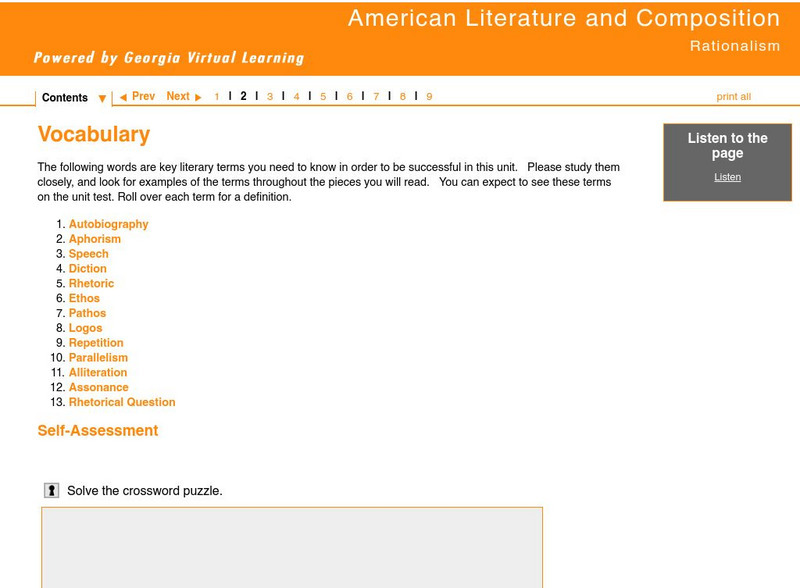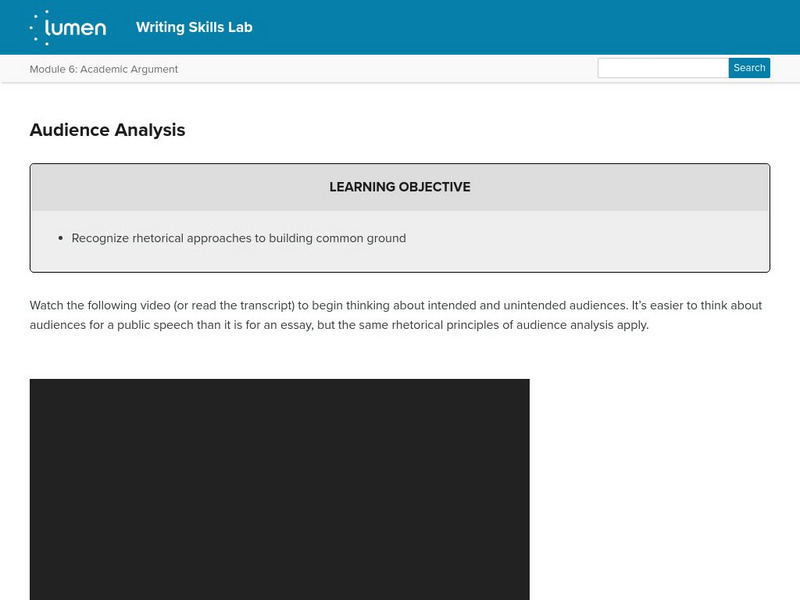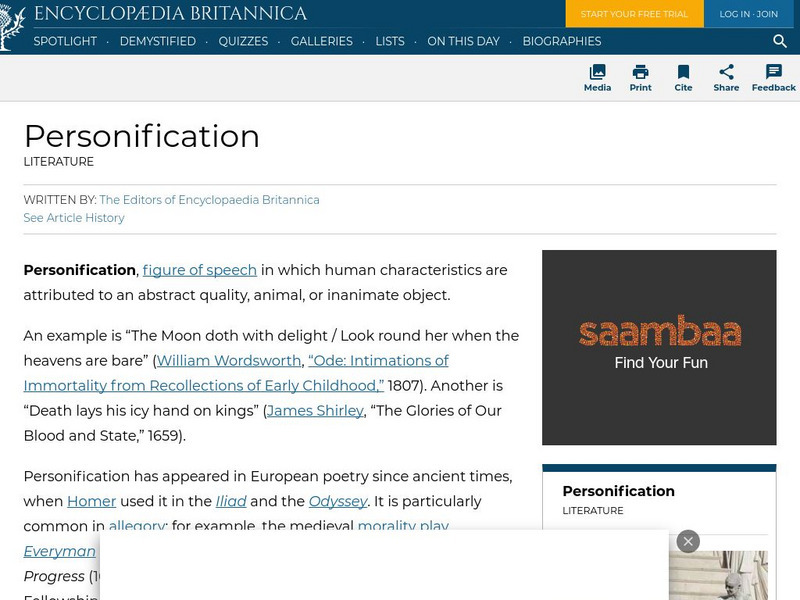Georgia Department of Education
Ga Virtual Learning:20th Century and Modern Poetry: Ww Ii: Sir Winston Churchill
This lesson from a unit on 20th Century and Modern Poetry focuses on Sir Winston Churchill and his award-winning speeches during WW II. It features links to a brief history "England in World War II," a Winston Churchill biography, a list...
Sophia Learning
Sophia: Types of Questions
This slideshow lesson focuses on types of questions; it provides background, purpose, and a list of the seven types of questions: rhetorical, direct or interrogative, indirect, open-ended, closed, and embedded. It provides background and...
Department of Defense
Do Dea: Contemplation and Argumentation
In this self-guided unit, you will read Romantic and Transcendental literature and you will practice the art of persuasion using rhetorical devices, appeals, and refutation while avoiding logical fallacies. By the end of the unit, you...
ClassFlow
Class Flow: Oxymoron
[Free Registration/Login Required] In this interactive lesson, students will explore how oxymora are used in writing and look at examples. Complete description of this rhetorical effect.
Sophia Learning
Sophia: Hyperbole
This lesson introduces hyperbole as a rhetorical device. This tutorial lesson shares a short slideshow with the lesson's content.
Georgia Department of Education
Ga Virtual Learning: American Literature and Comp: Rationalism: Vocabulary
This lesson focuses on the literary terms needed for the unit on Rationalism. I provides a list of terms and a crossword puzzle using them.
Texas Education Agency
Texas Gateway: Understatement/overstatement (English I Reading)
A learning module that teaches students to recognize hyperbole and understatement as literary devices in five modules: Introduction, Recognizing Hyperbole and Understanding Its Purpose, Identifying Hyperbole in Poetry, Recognizing...
Other
How to Analyze a Speech
An interesting approach to how to analyze a speech. Presents a rhetorical pentangle as well as a rhetorical triangle, where each of the vertices represents an item to analyze. There is also an outline of the different areas to examine in...
Sophia Learning
Sophia: Referencing the Author's Purpose
This lesson explains how to reference an author's purpose when answering a reading comprehension question. This tutorial shares an audio version of the lesson's content. [3:14] RI.11-12.6 Eval Purpose, Rhetoric, Style
Lumen Learning
Lumen: Critical Reading: Reading Strategies
This lesson focuses on reading strategies including scanning, skimming, SQ3R, High-5 Reading Strategies, technology, and rhetorical context. It includes text information and videos.
Lumen Learning
Lumen: Writing Process: Prewriting
This lesson focuses on prewriting including the purpose and characteristics of prewriting, prewriting strategies, the rhetorical context, and developing a working thesis statement. It also includes a slide show about author, audience,...
Lumen Learning
Lumen: Writing Skills: Audience Analysis
This lesson focuses on audience analysis and recognizing rhetorical approaches to building common ground. A practice activity is provided.
National Endowment for the Humanities
Neh: Edsit Ement: Animal Farm: Allegory and the Art of Persuasion
This lesson plan will introduce students to the concept of allegory by using George Orwell's widely read novella, Animal Farm. Through this novel, students will learn what an allegory is, the rhetorical components of an allegory, and...
Encyclopedia Britannica
Encyclopedia Britannica: Literature: Personification
Explains what personification is and gives examples. Includes links to related articles on symbolism, elements of rhetoric, fables, figure of speech, and allegory.
SparkNotes
Spark Notes: Julius Caesar: Themes
A discussion of the themes in The Tragedy of Julius Caesar, including fate vs. free will, public self vs. private self, misinterpretations and misreadings, inflexibility vs. compromise, and rhetoric and power. Also has link to a quiz on...
Pennsylvania State University
Pennsylvania State University (Dr. Mc Clennen): How to Do a Close Reading
This guide is written for college students, but should be very useful for upper level high school students as well. The writer first describes fourteen steps to take in doing a close reading, then provides six pieces of advice on how to...
Louisiana Department of Education
Louisiana Doe: Louisiana Believes: Unit: Politics
Students explore the impact language has on politics and social beliefs. They explore the evolution of language (drawing on the knowledge gained through previous research), consider how language evolves, and explore who controls language...
American Rhetoric
American Rhetoric: Franklin Delano Roosevelt: Commonwealth Club Address
This is the text of Franklin D. Roosevelt's speech to the Commonwealth Club on September 23, 1932, in San Francisco, California.
American Rhetoric
American Rhetoric: Andre Agassi Farewell to Tennis Address at the u.s. Open
This is the text, audio, and video [2:28] of Andre Agassi's farewell address to tennis at the U. S. Open on September 3, 2006.
American Rhetoric
American Rhetoric: Ursula K. Le Guin: A Left Handed Commencement Address
This is the text of Ursula K. Le Guin's commencement address to graduates of 1983, Mills College, Oakland, California on May 22, 1983. She titled her speech "A Left-Handed Commencement Address."
Rutgers University
Rutgers University: Glossary of Literary and Rhetorical Terms: Synecdoche
Brief definition with links to information on related literary terms and examples.
Other popular searches
- Rhetorical Devices
- Public Speaking Rhetoric
- Gettysburg Address Rhetoric
- Rhetorical Questions
- Speech and Rhetoric
- Rhetorical Analysis
- Rhetoric Logos Pathos Ethos
- Political Rhetoric
- Speeches Rhetoric
- Rhetorical Devices in Songs
- Speech Rhetorical Devices
- Rhetorical Strategies





















